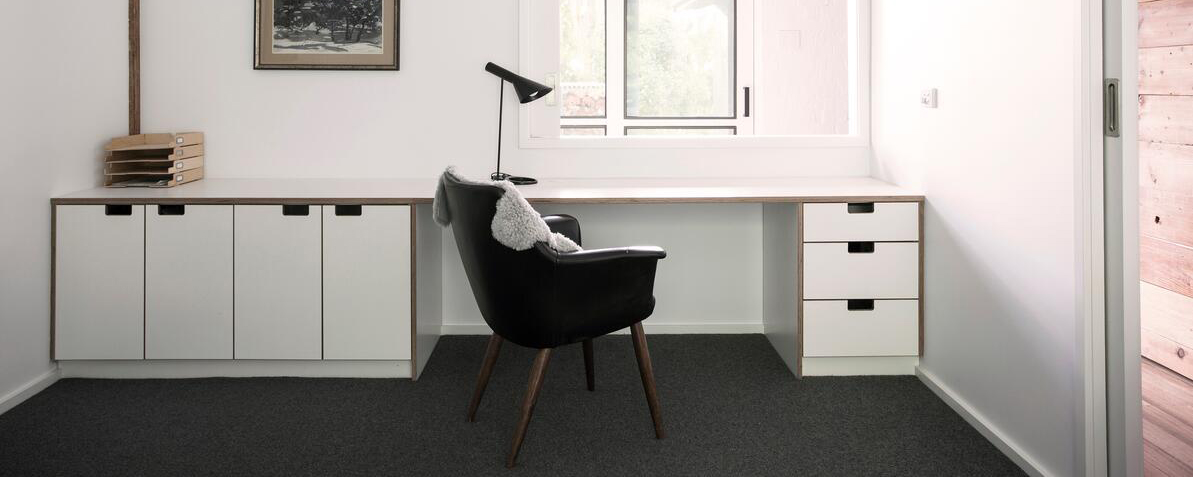05—07—2017
Plywood Doors - What's the Real Story?
Some of the most common questions we get asked include: ‘Can you use ply for doors?’ and ‘What thickness or door size can I do using plywood?’
The reality is that there is no correct or solid answer to these questions!
Plywood is an engineered product manufactured from natural timber veneers and as a result, reacts and responds to the environment in which it finds itself. Variations in moisture, temperature and the environment itself will all have effects on a plywood panel and these variables all contribute to how flat a plywood panel or door is and will remain.
How a plywood sheet is stored before installation or being used is also another critical matter. Plywood sheets must always be stored flat with full-width timber bearers at maximum 1000mm apart (that’s 3 timber bearers for a standard 2400 X 1200mm sheet) with cover sheets top & bottom. The plywood must be out of direct sunlight, undercover and away from any source of moisture or temperature variations and MAXI Plywood recommends that the ply is left for 48 hours to acclimatise to its current environment before being machined or cut. Never store plywood standing on its side or ends.
Once cut and machined it is critical that all exposed faces and edges (front, back and sides) are properly sealed with a suitable Oil or Lacquer.
All of these factors above show that there are many variables that are outside of our control once we’ve made the delivery to our client or customer. Plywood does react and behave differently to man-made products like MDF and Particleboard and as a result, Maxiply does not recommend that any plywood is used for doors or floating shelves in joinery projects and cannot cover or replace plywood if it twists or bows once the sheets have been cut. Our warranty covers the replacement of the sheet provided the sheet is not cut or damaged – once the ply is cut though we can no longer be responsible for its behaviour.
Hence it’s critical that the Joinery Shop or Cabinet Maker has sufficient experience with using plywood in order to get the desired results. We have supplied hundreds of Birch plywood sheets to many experienced shops over the past 5 years where doors have been made which proves that it can be done with the correct approach and care.
Maxiply encourages and welcomes Specifiers and Designers to discuss their specific projects with us so that we can advise and recommend products as best suited to your requirements – because even though you may want the plywood-edge look for a door, there are other options open to you which we can discuss.
Contact our friendly team today on 1300 761 741 to discuss your project!
or, read our blog ‘Everything to Know about Ply for Doors’ for a highlight on what we generally recommend.

05—07—2017
Some of the most common questions we get asked include: ‘Can you use ply for doors?’ and ‘What thickness or door size can I do using plywood?’
The reality is that there is no correct or solid answer to these questions!
Plywood is an engineered product manufactured from natural timber veneers and as a result, reacts and responds to the environment in which it finds itself. Variations in moisture, temperature and the environment itself will all have effects on a plywood panel and these variables all contribute to how flat a plywood panel or door is and will remain.
How a plywood sheet is stored before installation or being used is also another critical matter. Plywood sheets must always be stored flat with full-width timber bearers at maximum 1000mm apart (that’s 3 timber bearers for a standard 2400 X 1200mm sheet) with cover sheets top & bottom. The plywood must be out of direct sunlight, undercover and away from any source of moisture or temperature variations and MAXI Plywood recommends that the ply is left for 48 hours to acclimatise to its current environment before being machined or cut. Never store plywood standing on its side or ends.
Once cut and machined it is critical that all exposed faces and edges (front, back and sides) are properly sealed with a suitable Oil or Lacquer.
All of these factors above show that there are many variables that are outside of our control once we’ve made the delivery to our client or customer. Plywood does react and behave differently to man-made products like MDF and Particleboard and as a result, Maxiply does not recommend that any plywood is used for doors or floating shelves in joinery projects and cannot cover or replace plywood if it twists or bows once the sheets have been cut. Our warranty covers the replacement of the sheet provided the sheet is not cut or damaged – once the ply is cut though we can no longer be responsible for its behaviour.
Hence it’s critical that the Joinery Shop or Cabinet Maker has sufficient experience with using plywood in order to get the desired results. We have supplied hundreds of Birch plywood sheets to many experienced shops over the past 5 years where doors have been made which proves that it can be done with the correct approach and care.
Maxiply encourages and welcomes Specifiers and Designers to discuss their specific projects with us so that we can advise and recommend products as best suited to your requirements – because even though you may want the plywood-edge look for a door, there are other options open to you which we can discuss.
Contact our friendly team today on 1300 761 741 to discuss your project!
or, read our blog ‘Everything to Know about Ply for Doors’ for a highlight on what we generally recommend.








